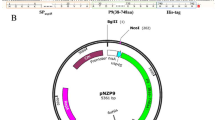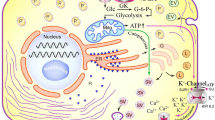Abstract
Ghrelin is mainly produced by the stomach, although it is expressed in other tissues, including the pancreas. Among its pleiotropic actions, ghrelin prevents the development of diabetes in rats and exerts mitogenic and antiapoptotic effects in different cell types. In addition, a ghrelin -producing ε-cell population has been demonstrated in rodent islets, suggesting a direct role in the control of islet cell survival. In this study, we investigated the effect of acylated ghrelin (AG) and unacylated ghrelin (UAG) on cell survival of HIT-T15 pancreatic β cells. We show that both AG and UAG equally prevented β cell death induced by serum withdrawal. In addition, both peptides inhibited serum starvation-induced apoptosis. These findings indicate that UAG and AG prevent cell death and apoptosis of pancreatic β cells. Since only AG, but not UAG, binds the GRLN receptor, a different and as yet unknown receptor is likely involved in these survival mechanisms.
Similar content being viewed by others
References
Kojima M, Hosoda H, Date Y, Nakazato M, Matsuo H, Kangawa K. Ghrelin is a growth-hormone-releasing acylated peptide from stomach. Nature 1999, 402: 656–60.
van der Lely AJ, Tschop M, Heiman ML, Ghigo E. Biological, physiological, pathophysiological, and pharmacological aspects of ghrelin. Endocr Rev 2004, 25: 426–57.
Davenport AP, Bonner TI, Foord SM, et al. International Union of Pharmacology. LVI. Ghrelin receptor nomenclature, distribution, and function. Pharmacol Rev 2005, 57: 541–6.
Prado CL, Pugh-Bernard AE, Elghazi L, et al. Ghrelin cells replace insulin-producing beta cells in two mouse models of pancreas development. Proc Natl Acad Sci USA 2004, 101: 2924–9.
Wierup N, Yang S, McEvilly RJ, Mulder H, Sundler F. Ghrelin is expressed in a novel endocrine cell type in developing rat islets and inhibits insulin secretion from INS-1 (832/13) cells. J Histochem Cytochem 2004, 52: 301–10.
Sun Y, Wang P, Zheng H, Smith RG. Ghrelin stimulation of growth hormone release and appetite is mediated through the growth hormone secretagogue receptor. Proc Natl Acad Sci USA 2004, 101: 4679–84.
Broglio F, Prodam F, Me E, et al. Ghrelin: endocrine, metabolic and cardiovascular actions. J Endocrinol Invest 2005, 28: 23–5.
Baldanzi G, Filigheddu N, Cutrupi S, et al. Ghrelin and des-acyl ghrelin inhibit cell death in cardiomyocytes and endothelial cells through ERK1/2 and PI 3-kinase/AKT. J Cell Biol 2002, 159: 1029–37.
Pettersson I, Muccioli G, Granata R, et al. Natural (ghrelin) and synthetic (hexarelin) GH secretagogues stimulate H9c2 cardiomyocyte cell proliferation. J Endocrinol 2002, 175: 201–9.
Irako T, Akamizu T, Hosoda H, et al. Ghrelin prevents development of diabetes at adult age in streptozotocin-treated newborn rats. Diabetologia 2006, 49: 1264–73.
Kurrer MO, Pakala SV, Hanson HL, Katz JD. Beta cell apoptosis in T cell-mediated autoimmune diabetes. Proc Natl Acad Sci USA 1997, 94: 213–18.
Rhodes CJ. Type 2 diabetes-a matter of beta-cell life and death? Science 2005, 307: 380–4.
Santerre RF, Cook RA, Crisel RM, et al. Insulin synthesis in a clonal cell line of simian virus 40-transformed hamster pancreatic beta cells. Proc Natl Acad Sci USA 1981, 78: 4339–43.
Granata R, Trovato L, Garbarino G, et al. Dual effects of IGFBP-3 on endothelial cell apoptosis and survival: involvement of the sphingolipid signaling pathways. FASEB J 2004, 18: 1456–8.
Wang J, Lenardo MJ. Roles of caspases in apoptosis, development, and cytokine maturation revealed by homozygous gene deficiencies. J Cell Sci 2000, 113: 753–7.
Author information
Authors and Affiliations
Corresponding author
Rights and permissions
About this article
Cite this article
Granata, R., Settanni, F., Trovato, L. et al. Unacylated as well as acylated ghrelin promotes cell survival and inhibit apoptosis in HIT-T15 pancreatic β -cells. J Endocrinol Invest 29, RC19–RC22 (2006). https://doi.org/10.1007/BF03347367
Accepted:
Published:
Issue Date:
DOI: https://doi.org/10.1007/BF03347367




